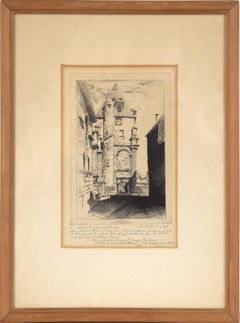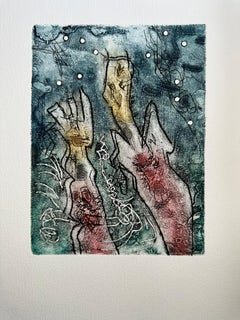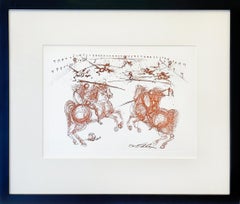Art by Medium: Engraving
1940s Victorian Art by Medium: Engraving
Ink, Etching, Drypoint, Paper
1990s Surrealist Art by Medium: Engraving
Engraving, Aquatint
1970s Surrealist Art by Medium: Engraving
Drypoint, Engraving
1980s Contemporary Art by Medium: Engraving
Drypoint
20th Century Modern Art by Medium: Engraving
Drypoint, Aquatint
Late 20th Century Abstract Art by Medium: Engraving
Engraving
1970s Surrealist Art by Medium: Engraving
Drypoint, Engraving, Color
1960s Surrealist Art by Medium: Engraving
Drypoint
1970s Surrealist Art by Medium: Engraving
Drypoint
1970s Abstract Expressionist Art by Medium: Engraving
Lithograph, Engraving
Early 1900s Art by Medium: Engraving
Etching, Aquatint, Drypoint
1980s Contemporary Art by Medium: Engraving
Paper, Engraving, Screen
1960s Surrealist Art by Medium: Engraving
Watercolor, Etching, Drypoint, Paper
1970s Surrealist Art by Medium: Engraving
Drypoint, Color Pencil
1960s Surrealist Art by Medium: Engraving
Watercolor, Paper, Drypoint, Etching
1970s Surrealist Art by Medium: Engraving
Drypoint, Etching
Mid-20th Century Surrealist Art by Medium: Engraving
Engraving
1970s Surrealist Art by Medium: Engraving
Drypoint
1960s Surrealist Art by Medium: Engraving
Drypoint, Watercolor
20th Century Contemporary Art by Medium: Engraving
Paper, Cotton, Engraving
1960s Surrealist Art by Medium: Engraving
Watercolor, Etching, Drypoint, Paper
1960s Surrealist Art by Medium: Engraving
Engraving, Drypoint
1970s Surrealist Art by Medium: Engraving
Engraving, Drypoint
20th Century Surrealist Art by Medium: Engraving
Lithograph, Drypoint
1960s Surrealist Art by Medium: Engraving
Engraving, Drypoint
1990s Contemporary Art by Medium: Engraving
Mezzotint
1970s Art by Medium: Engraving
Engraving
20th Century Surrealist Art by Medium: Engraving
Etching, Engraving
20th Century Surrealist Art by Medium: Engraving
Lithograph, Drypoint
1980s Contemporary Art by Medium: Engraving
Engraving, Paper, Etching, Aquatint
1970s Contemporary Art by Medium: Engraving
Drypoint
1940s Art by Medium: Engraving
Drypoint, Aquatint
1970s Surrealist Art by Medium: Engraving
Drypoint, Color Pencil
1970s Surrealist Art by Medium: Engraving
Paper, Drypoint, Etching
1960s Cubist Art by Medium: Engraving
Aquatint, Drypoint, Etching
1980s Contemporary Art by Medium: Engraving
Engraving, Paper, Etching, Aquatint
1960s Surrealist Art by Medium: Engraving
Watercolor, Etching, Drypoint, Paper
1970s Surrealist Art by Medium: Engraving
Drypoint, Paper, Aquatint
1920s American Modern Art by Medium: Engraving
Drypoint
1980s Contemporary Art by Medium: Engraving
Mezzotint
1980s Surrealist Art by Medium: Engraving
Engraving, Screen, Paper
1970s Surrealist Art by Medium: Engraving
Drypoint, Paper, Aquatint
1970s Surrealist Art by Medium: Engraving
Drypoint, Paper, Aquatint
1970s Surrealist Art by Medium: Engraving
Drypoint, Paper, Aquatint
1970s Surrealist Art by Medium: Engraving
Drypoint, Paper, Aquatint
1970s Surrealist Art by Medium: Engraving
Drypoint, Paper, Aquatint
1980s Abstract Art by Medium: Engraving
Paper, Drypoint
Late 20th Century Surrealist Art by Medium: Engraving
Drypoint, Paper
Early 20th Century American Modern Art by Medium: Engraving
Drypoint, Etching
1970s Surrealist Art by Medium: Engraving
Drypoint, Paper, Aquatint
1980s Abstract Art by Medium: Engraving
Paper, Drypoint
1970s Surrealist Art by Medium: Engraving
Drypoint, Paper, Aquatint
1920s Surrealist Art by Medium: Engraving
Drypoint, Etching
1970s Surrealist Art by Medium: Engraving
Drypoint, Aquatint, Paper
Early 20th Century Post-Impressionist Art by Medium: Engraving
Drypoint
1950s Cubist Art by Medium: Engraving
Drypoint
1950s Abstract Art by Medium: Engraving
Drypoint, Etching, Monotype
1970s Surrealist Art by Medium: Engraving
Drypoint, Aquatint, Paper




